
If you have questions about purchasing a license call 1-800-5GO-HUNT.
Mississippi is home to two subspecies of black bears. The American black bear (Ursus americanus) is found in the northern one-third of the state, and the Louisiana black bear (Ursus americanus luteolus) occurs in the southern two-thirds. The Louisiana black bear (recently removed from the Federally Threatened Species list) and the American black bear are both classified as Endangered under Mississippi law. The two subspecies vary only in skull morphology and genetic makeup; to the naked eye, they are indistinguishable.
The MDWFP Black Bear Program began in June of 2002 at the Mississippi Museum of Natural Science. The initial focus of the program was to conduct research on Mississippi black bears in an effort to learn more about this endangered species. At the time of the program's inception, it was estimated that there were fewer than 50 bears residing in the state. Today, estimates of our bear population have more than tripled. This population increase is due primarily to the recent appearance of female bears in our state, which led to the births of numerous cubs in the last several years--something not documented in Mississippi in the previous 40 years.
There are currently three breeding sub-populations of black bears in Mississippi. Additionally, general sightings of bears have increased dramatically all over the state, likely due to dispersing bears from populations in neighboring states. The Black Bear Program is now within the Wildlife Bureau of the Mississippi Department of Wildlife, Fisheries, and Parks and continues to conduct research and educate the people of Mississippi about our black bears. Another primary objective of the program is the prevention of conflicts between bears and people.
If you are experiencing problems involving black bears or want to report a recent bear sighting, please contact MDWFP at (601) 432-2199.
Anthony Ballard
anthony.ballard@wfp.ms.gov
(601) 432-2242
Black bears have played a substantial role in the heritage and history of Mississippi. Native Americans used the black bear as a source of food, clothing, and goods for trade with European travelers. As settlers moved into the area, black bear hunting from horseback became a popular sport. There are few areas in the southeastern U. S. with as rich of a bear hunting tradition as Mississippi. The vast acreages of bottomland hardwood forests and impenetrable canebrakes of the Mississippi Delta were home to high densities of black bears at the turn of the century.
 The Teddy Roosevelt Bear Hunts
The Teddy Roosevelt Bear HuntsThe lure of hunting bear from horseback with the aid of dogs created some of the earliest legends of bear hunting, while attracting many dignitaries and heads of state from across the country. Of course, no other bear hunt is quite as famous as the Teddy Roosevelt hunt. Roosevelt had long wanted to participate in a Delta bear hunt and was invited to do so in the fall of 1902. On November 14, his party hunted on Smedes Plantation in southwestern Sharkey County. The guide was a former slave named Holt Collier, the most accomplished bear hunter in the nation's history. On the day before the hunt, in a display of self-confidence, Collier predicted that he would help the president get a bear if he had to catch it and tie it to a tree himself. The rest, as they say, is history.
Factual details of the hunt and the life of Holt Collier can be found in Minor Buchanan's book, Holt Collier: His Life, His Roosevelt Hunts, and the Origin of the Teddy Bear. Suffice it to say that they do not match the media accounts or the political cartoon "Drawing the Line in Mississippi". It is true, however, that Roosevelt declined the opportunity to kill a bear not taken in fair chase. After hearing about the event, a toy maker requested the President's permission to name his small stuffed bears “Teddy's Bear”, hence the birth of one of Americas most famous children's toys.
By the early 1900s, bear numbers saw a sharp decline due to overhunting and habitat destruction and fragmentation. Black bears were nearly extirpated from the Mississippi landscape with fewer than a dozen individuals remaining. In 1932, the black bear was given statewide protection and was later included on the first list of rare and threatened vertebrates of Mississippi in 1974. In 1984, the black bear was listed as an endangered species in the state, where it remains today.
 BearWise
BearWiseBearWise.org is a regional program based in the southeastern U.S. that shares ways to prevent conflicts, provides resources to resolve problems, and encourages community initiatives to keep bears wild. BearWise is supported by the 15 member-state Southeastern Association of Fish and Wildlife Agencies (SEAFWA) and was developed by members of the Large Carnivore Working Group of SEAFWA's Wildlife Resources Committee.
It is widely agreed that observation of bears is best done from a distance. When bears come too close to our homes, hunting camps, favorite fishing hole, or campsite, it ultimately results in some sort of conflict. Bear conflicts generally revolve around one thing: food. Bears are opportunistic foragers and will take full advantage of any easy meal. In most any case involving a nuisance bear, if you remove the food, you remove the problem. A primary objective of the MDWFP is to provide technical guidance to reduce human conflict with bears. As with many things, prevention is the best solution to any bear conflict.
Intentionally feeding bears habituates bears to humans. Bears that no longer have a fear of humans can become extremely dangerous. In addition to becoming comfortable around humans, the most dangerous aspect of feeding bears is that bears then associate humans with acquiring food. Bears come to expect a free meal and will come to humans to get it; the danger comes when bears demand their free meal. Feeding a bear around your home not only puts you at risk of personal injury and property damage but puts your neighbors and their property at risk as well.
In order to move the bear, it must first be captured and immobilized, then transported. This is a costly procedure that puts the bear at considerable risk. In addition, moving a bear that has grown accustomed to unnatural foods does not solve the problem but merely moves it to another area. Additionally, bears have an amazing homing instinct and will usually try to return to familiar territory. Along the way, they cross unfamiliar territory and can wander into urban areas or cross busy roadways, which can lead to fatal results for both bears and people.
Mississippi black bears are normally very shy and secretive animals and are not aggressive towards humans. Black bears, by nature, are not predatory. Black bear attacks in general are very rare and in most cases are the result of underlying causes, most of which are avoidable. There has never been a case documented in Mississippi of a human being attacked by a bear; however, bears are large, powerful wild animals and should be treated with caution and respect.
Bears have acute senses of hearing and smell; in many cases, a bear will know you are coming and leave the area before you are aware of their presence. However, if you were to encounter a bear in the wild, one of two actions are most common. The bear may immediately run away when it sees you, or the bear may stand tall on its hind legs. Contrary to popular belief, this is not aggressive behavior of any kind, and the bear is not getting ready to charge or attack. The bear is simply standing up to get a better look at what it has just encountered. Even in the case of a female with her young, generally bears do not aggressively defend their cubs. After the bear sees what you are, it will likely go back down on all fours and leave the area either walking or running.
If the bear feels cornered or stands its ground to protect its food, it will exhibit defensive aggressive behavior. This behavior is the bear's way of saying, "You are too close and need to back off." The bear will "pump" the ground, appearing to do short, choppy push-ups, and you may hear a loud popping noise, which is the bear popping its jaws together. Quick snorts or huffing sounds are also common during this type of behavior display. In some cases, the bear may even "false charge", meaning that the bear will quickly run within a few feet of you and stop.
For helpful tips for preventing human/wildlife conflicts in residential and outdoor areas that attract black bears, see Living with Bears.
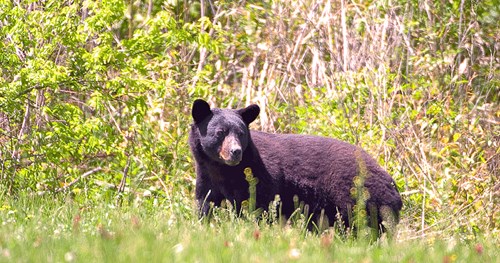 Black bears are generally black with a brown muzzle and commonly have a chest marking called a blaze. This blaze can be as little as a few white hairs to a large white patch. Black bears are compact and strong boned with small eyes, small round ears, and a short tail that can vary from 3-6 inches in length.
Black bears are generally black with a brown muzzle and commonly have a chest marking called a blaze. This blaze can be as little as a few white hairs to a large white patch. Black bears are compact and strong boned with small eyes, small round ears, and a short tail that can vary from 3-6 inches in length.
Average body weights of black bears are 150-400+ lbs for adult males and 100-250 lbs for adult females, though much larger individuals have been documented in Mississippi as well as throughout the southeast. Black bears range from 3-6 feet long from nose to tail and 2-3 feet tall at the shoulder. Females generally reach full size at 5 years of age, while males will not reach their full potential until 8 years of age. Both sexes can continue to increase in body mass as they get older.
Black bears have relatively poor eyesight but possess acute near-vision and can see in color. Black bears are referred to as "plantigrade" (meaning they walk flat on the soles of their feet similar to humans), with short, non-retractable claws on the end of each of their five toes. They are able to run at speeds of up 35 mph and are exceptional swimmers. Black bears are very intelligent animals with a keen memory and a phenomenal sense of smell.
The black bear's range covers most of the North American continent. They are found in Alaska, much of Canada and the United States, and extend as far south as northern Mexico.
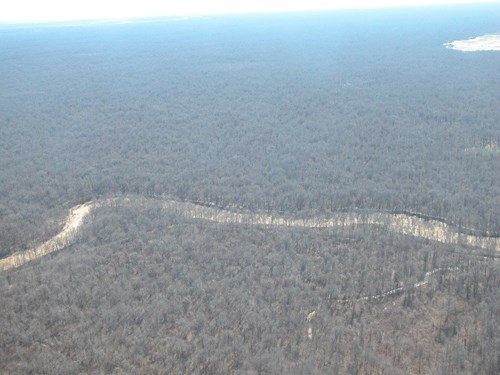 Mississippi Range and Population Status
Mississippi Range and Population StatusThere are two subspecies of black bear in Mississippi: the American black bear, in the northern part of the state, and the Louisiana black bear, found in the southern two-thirds of the state.
Most of the bears in the state are found along the drainages of major rivers such as the Mississippi, Pearl, and Pascagoula, although bears can and have been known to show up just about anywhere. In more recent years, bears are beginning to move north from the coast and east from the Mississippi River. At one time, most of the bears found in the state were likely transient males that wandered across state lines. They were the dispersing products of breeding populations of bears that border our state in Arkansas, Louisiana, and Alabama.
For black bear populations to grow and their overall range to expand, expansion of breeding females is key. Since 2005, the MDWFP has documented the births of over 30 cubs in the state. This is a major milestone, as prior to 2005, there had been no documentation of cubs for 40 years. MDWFP biologists currently estimate the Mississippi bear population to be about 150 bears in the state, which is a major improvement over the estimated 40 individuals in 2002.
Black bears are currently found in three general areas within the state: the Gulf Coast, the Loess Bluffs of southwest Mississippi, and the Mississippi River Delta. Range sizes vary depending on habitat quality. The average home range for an adult male bear is roughly 20,000 acres, while the average home range for an adult female is roughly 5,000 acres. Home range for black bears is influenced by several factors. Habitat type, sex, age, season, environmental conditions, food availability, and population density all play a significant role in determining size and shape of a bear’s range. Range sizes typically increase during the summer mating season and during fall when bears are foraging heavily to build fat reserves.
 Sightings
SightingsBlack bear sightings in Mississippi have been on the rise in the last few years, especially during the early summer when yearling bears are dispersing to establish a home range and breeding season for the adult bears occurs. Not only is the actual number of bears increasing, but public awareness has increased as well. The majority of sightings have come from counties bordering the Mississippi River and from coastal counties such as Jackson, Harrison, and Stone.
Each year, however, more sightings are occurring towards the central part of the state. Almost everyone that reports seeing a bear or bear sign on their property is genuinely excited about the possibility of having a bear in the area. To tell the truth, most of the people who report bear sightings have likely had bears in the area for years. They would never have caught a glimpse of these shy creatures, though, without being made aware of them through the use of motion-sensor cameras.
Movements within the range of a bear are primarily for meeting habitat needs and finding potential mates. Bears are most active from dusk through dawn and will often use daybeds during daylight hours. Mothers with cubs often rest at the base of a tree so, if disturbed, she can send the cubs into the safety of the tree.
As with many other factors relating to bears, movement is related to time of year. Immediately after emerging from the den, bears exhibit decreased activity while the remainder of fat reserves are used. Bears become more active throughout the spring as more food becomes available. During the late spring and early summer, bears are at one of their most active times of the year. This is due to a few different factors, including the transition from spring to summer forage; yearling bears (primarily males) being pushed away from the mother, who is ready to breed again; and the breeding season being in full swing. During the fall, bears are also active, as they are searching the landscape for food to build fat reserves to last them through the coming winter.
Bears use many different kinds of habitats within their home ranges. While they may use mature hardwood forests for hard mast and den trees, bears also benefit from cutover areas that provide escape cover and soft mast food sources. Studies have shown that bears favor areas with the least amount of disturbance from humans, yet another testament to their shy nature.
 One of the leading factors in the decline of Mississippi black bears since the turn of the century is habitat destruction and fragmentation. The once majestic bottomland hardwood forests of the Mississippi Alluvial Valley (MAV) have been reduced to scattered and isolated remnants of their former glory. Many of the vast swamps and lowland areas, which served as safe havens for thousands of bears throughout Mississippi, have been drained and cleared so that the fertile black soils can be used for agriculture. By 1980, more than 80 percent of the bottomland hardwood forests of the MAV had disappeared.
One of the leading factors in the decline of Mississippi black bears since the turn of the century is habitat destruction and fragmentation. The once majestic bottomland hardwood forests of the Mississippi Alluvial Valley (MAV) have been reduced to scattered and isolated remnants of their former glory. Many of the vast swamps and lowland areas, which served as safe havens for thousands of bears throughout Mississippi, have been drained and cleared so that the fertile black soils can be used for agriculture. By 1980, more than 80 percent of the bottomland hardwood forests of the MAV had disappeared.
However, over the last few decades, habitats for bears, as well as countless other species of wildlife, have been on the mend, especially in the Delta region of the state. Through government programs, such as the former Wetland Reserve Program (WRP) (Currently the Wetland Reserve Easement, WRE) and the Conservation Reserve Program (CRP), thousands of acres of marginal farmlands have been planted in bottomland hardwood species of trees. These replanted areas not only provide increased habitat for bears but also serve as corridors linking isolated patches of hardwood forests found on public and private lands throughout the Delta.
Black bears are classified as carnivores; however, this is largely misleading as they are not active predators and have been documented to have a diet consisting of as much as 96% plant material. In fact, black bears are the least predacious species of all North American carnivores. Biologically speaking, black bears are omnivores, but they are primarily vegetarians.
 Black bears are opportunistic feeders and are quite lazy when it comes to finding food. Bears will take full advantage of any easy meal that is provided to them, including carrion (animals that died of other causes), wildlife feeders, and household garbage. A black bear's digestive system is poor at breaking down vegetation, and as a result, they must consume large amounts of food to gather the nutrients needed for survival. With the large amount of time black bears spend foraging, their movements across the landscape and habitat usage are closely related to food. The excellent memory of a black bear comes into play with food sources, as they will remember areas with ample forage and will revisit it until the source is no longer available.
Black bears are opportunistic feeders and are quite lazy when it comes to finding food. Bears will take full advantage of any easy meal that is provided to them, including carrion (animals that died of other causes), wildlife feeders, and household garbage. A black bear's digestive system is poor at breaking down vegetation, and as a result, they must consume large amounts of food to gather the nutrients needed for survival. With the large amount of time black bears spend foraging, their movements across the landscape and habitat usage are closely related to food. The excellent memory of a black bear comes into play with food sources, as they will remember areas with ample forage and will revisit it until the source is no longer available.
Black bear food selection can be broken down into sections largely related to seasonal changes, which dictate what is available on the landscape.
During the spring, bears often use fat reserves left from the denning season and may be in a state of fasting for some time. Post-den emergence is when food sources are most scarce; bears will feed on residual hard mast, and green vegetation as it becomes available. Grasses and forbs make up the majority of a bear's diet in the spring, and they have been known to frequent food plots consisting of wheat, oats, and clover. Bears will also move fallen logs in the forest to find insects such as beetles and larva.
As early season plants become less desirable, bears begin to seek out soft masts such as blackberries, pokeweed, red mulberry, etc. Holding true to their feeding habits, bears prefer foods such as fruits and berries that do not move around. Bears also feed on a variety of insects (which can total as much as 15% of their summer diet), including yellow jackets, honeybees, bumblebees, and carpenter ants. Just like in the spring, bears will dig into old stumps and move logs around to find insects.
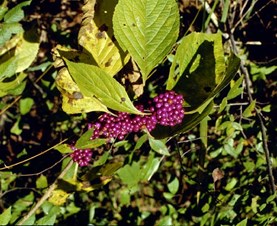

In the fall months, the bears' diet changes from a dominance of soft mast species to hard mast species such as oaks and hickories. However, in years of poor hard mast production, soft mast fruits still play a vital role in a black bear's diet. Hard mast species are vital in the fall, as this is the time of year bears exhibit their most weight gain in preparation for the winter. Hard mast is rich in fat and carbohydrates and is vital for bears in producing fat reserves that will ensure the bears enter the denning period in good health.
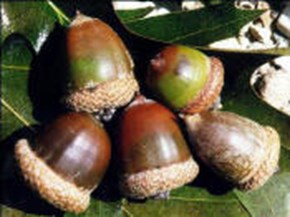
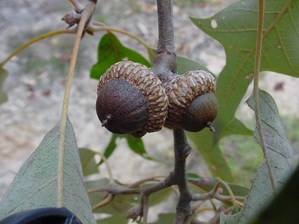
Ag crops can also play a supplemental role in black bear diets in Mississippi. This is especially true in fragmented habitats, such as those found in the Mississippi Delta. Black bears are commonly observed feeding on grain crops such as corn and sorghum during the summer and crops such as wheat and clover in the early winter and early spring. In agricultural areas, bears' diets in the summer can be comprised of as much as 50% corn and in winter can be as much as 60% wheat and oats. Black bears have also been documented feeding on rice crops in Mississippi and Arkansas.
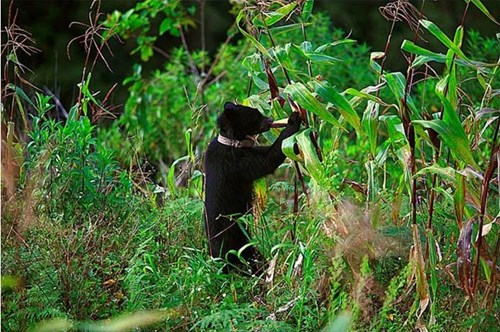

Male black bears typically reach sexual maturity at 3 to 4 years of age. Females generally breed for the first time at 3 to 6 years of age and will give birth every other year. Age of sexual maturity for both males and females is largely dependent on habitat quality.
Females come into estrus as early as late May and as late as August, with the peak of breeding taking place in July. Females will remain in estrus until they breed or until ovarian follicles begin to degenerate. Dominant males may mate with several females in an area. A dominance hierarchy determines access to females, with older, larger males displacing younger males.
Black bears exhibit what is called "delayed implantation". This means that after breeding, the fertilized egg remains in a state of suspension for about 5 months before implantation occurs and the fetus development begins. Fetal development takes place for 6-8 weeks before the cubs are born. Total time from breeding to cub birth is a little over 7 months. Cubs are born in winter dens during January with litter sizes ranging from 1 to 5. Cubs weigh only 8 ounces at birth but will weigh 4 to 5 pounds when they emerge from the den in April. Cubs will stay with their mother for 18 months before dispersing.
If a female's litter is lost prior to late summer, she may come into estrus and breed again, producing consecutive-year litters. Females may also deviate from the alternate-year cycle if they are not in sufficient health or nutrition to come into estrus during a particular year. Years of poor food production can cause reproductive failure within an entire population.
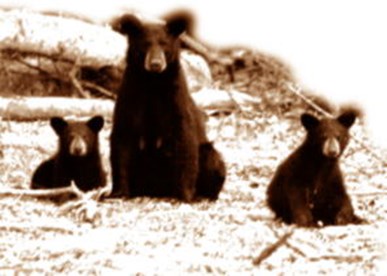
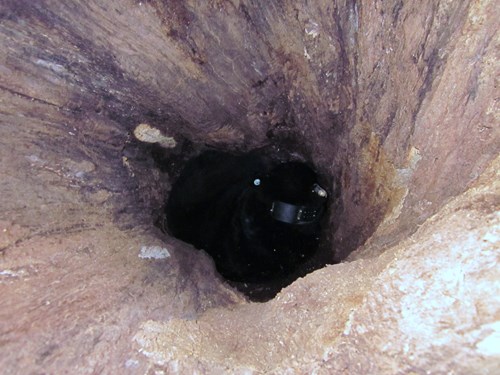 About Denning
About DenningBlack bears are not true hibernators but rather enter a period known as carnivorean lethargy, or "torpor". The primary purpose of this extended sleep is to survive food shortages and extreme weather during the winter months. During winter dormancy, black bears exhibit several physiological changes, including a decline in body temperature, a 50% decrease in metabolism, a decline in heart rate to 15-30 beats per minute, and approximately a 25% reduction in fat reserves.
Denning is not required for all bears in milder climates. With the exception of pregnant females, which must den in order to give birth, bears may remain active if sufficient food is available. Mississippi black bears typically have a shorter denning period and show greater winter activity than in other regions. This shorter duration is believed to be a function of greater food availability during winter months. Pregnant females typically will be the first to den, followed by females with young from that year, solitary females, and finally males.
 Once the females have denned, they generally remain there until the onset of spring unless they are disturbed. In some cases females may show some limited activity, leaving the cubs in the den to forage in the area around the den. Males have been documented to spend as little as a few weeks in the den before resuming activity. Upon emerging from the den, the reverse is seen, with males becoming active first, and females who have recently given birth being the last to end their denning season.
Once the females have denned, they generally remain there until the onset of spring unless they are disturbed. In some cases females may show some limited activity, leaving the cubs in the den to forage in the area around the den. Males have been documented to spend as little as a few weeks in the den before resuming activity. Upon emerging from the den, the reverse is seen, with males becoming active first, and females who have recently given birth being the last to end their denning season.
The type of den used by black bears in Mississippi varies greatly depending on the specific area in which the bear lives. Bears will use trees, standing snags, ground nests, logs, stumps, and piles of woody debris, and will excavate dens under trees, logs, or human structures. Tree dens are typically located along rivers, sloughs, or lakes and are made in cavities of bottomland hardwood trees, such as bald cypress or oak. In areas that are prone to flooding, elevated tree dens are preferred, especially by pregnant females, since they offer protection from the unpredictable floodwaters. However, in both higher ground and floodplain areas, concealment is generally the primary factor in black bears choosing a den site.
Black bears can live for over 25 years in the wild. Because black bears are such a long-lived animal with low reproductive rates, adult mortalities are especially harmful to growth and persistence of small bear populations like we have in Mississippi. Mortality of black bears can be attributed to both human and natural causes.
Natural causes of mortality include disease, cannibalism/infanticide (adult bears killing one another/adult bears killing cubs; both typically by adult males), drowning, maternal care accidents, and climbing accidents. Human-induced causes of mortality include habitat destruction, hunting, trapping, poaching, vehicle collisions, electrocution, and deaths associated with research activities. The highest mortality within a black bear population occurs from the time of dispersal (about 18 months of age) until sexual maturity and establishment of a home range (about 3 to 5 years of age).